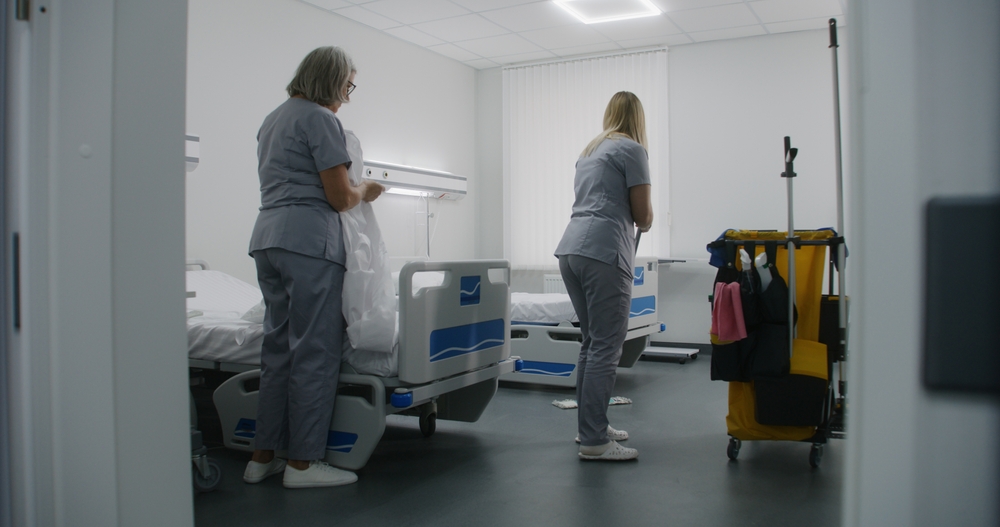Terminal cleaning is a process in healthcare facilities designed to ensure a sterile environment.
This deep cleaning method goes beyond routine sanitation, targeting every surface, corner, and piece of equipment in a patient’s room, especially after high-risk procedures or infectious disease cases.
By thoroughly disinfecting spaces, terminal cleaning plays a vital role in preventing the spread of infections and safeguarding patient health.
What is Terminal Cleaning?
Terminal cleaning is a rigorous cleaning procedure performed in healthcare settings aimed at eliminating pathogens and reducing the risk of infection. It involves the complete disinfection of a room, including all surfaces, medical equipment, and fixtures, particularly after a patient has been discharged or transferred. This process ensures that the environment is sterile, preventing cross-contamination and maintaining strict hygiene standards in medical facilities.
Why Terminal Cleaning is Essential in Medical Facilities
In medical facilities, terminal cleaning is crucial for infection control and patient safety. It plays a significant role in reducing hospital-acquired infections (HAIs) and maintaining a sanitary environment for both patients and healthcare workers.
- Prevents the Spread of Infections: Terminal cleaning thoroughly disinfects areas exposed to infectious diseases, reducing the risk of harmful pathogens lingering on surfaces and preventing cross-contamination.
- Ensures Patient and Staff Safety: A sanitized environment minimizes the risk of healthcare-associated infections, protecting both patients recovering from procedures and healthcare staff from potential exposure to hazardous pathogens.
- Supports Compliance with Health Regulations: Medical facilities are required to meet stringent cleanliness standards. Terminal cleaning helps healthcare providers adhere to these regulations, avoiding penalties and ensuring a safe space for treatment.

The Step-by-Step Terminal Cleaning Process
The terminal cleaning process follows a systematic approach to ensure that all areas are thoroughly sanitized and free of harmful pathogens. Below are the typical steps involved:
Step 1: Preparation
Cleaning staff don personal protective equipment (PPE) and gather the necessary disinfectants and tools to avoid contamination and protect themselves from harmful agents during the cleaning process.
Step 2: Removal of Disposable Items
All disposable materials, such as linens, bed pads, and medical waste, are removed from the room and properly disposed of in accordance with infection control protocols to reduce contamination risks.
Step 3: Surface Disinfection
High-touch surfaces like bed rails, door handles, and medical equipment are thoroughly disinfected using hospital-grade cleaning agents to eliminate bacteria, viruses, and other pathogens.
Step 4: Deep Cleaning and Final Inspection
Floors are mopped, walls and ceilings are wiped down, and any remaining surfaces are sanitized. Once completed, the room undergoes a final inspection to ensure that all areas meet cleanliness standards before being prepared for the next patient.
Tools and Products Used in Terminal Cleaning
Terminal cleaning in the operating room and other areas requires specialized tools and products to ensure thorough disinfection and sterilization of healthcare environments. These tools are designed to eliminate harmful pathogens and provide deep cleaning in critical areas.
- Hospital-grade Disinfectants: These powerful cleaning agents are designed to kill bacteria, viruses, and fungi, ensuring surfaces are properly sanitized.
- Microfiber Cloths and Mops: Used to remove dust, debris, and germs from surfaces without spreading contaminants, they are ideal for capturing fine particles.
- UV-C Light Devices: These tools emit ultraviolet light to destroy microorganisms on surfaces, providing an additional layer of sterilization after manual cleaning.
- HEPA-filtered Vacuums: High-efficiency particulate air vacuums trap tiny airborne particles, ensuring clean air and reducing the spread of pathogens.
- Personal Protective Equipment (PPE): Gloves, masks, gowns, and goggles are worn by cleaning staff to prevent exposure to harmful substances and cross-contamination.
The Benefits of Regular Terminal Cleaning
Regular terminal cleaning offers numerous benefits to both healthcare providers and patients. It ensures a hygienic environment and helps medical facilities operate at the highest safety standards.
Reduction in Infection Rates
Consistent terminal room cleaning drastically reduces the spread of healthcare-associated infections (HAIs) by eliminating pathogens from surfaces. This helps protect patients, visitors, and healthcare staff from potential disease transmission.
Improved Patient Outcomes and Safety
A cleaner, safer environment minimizes the risk of complications, promoting faster recovery and reducing readmission rates. Patients benefit from a sterile space that supports healing and protects them from secondary infections.
Enhanced Trust and Reputation for Medical Facilities
Facilities that maintain high hygiene standards through regular terminal cleaning build trust with patients and the community. A clean environment enhances the facility’s reputation, making it a preferred choice for care.
Compliance with Health Standards and Regulations
Regular terminal cleaning ensures that healthcare providers meet strict hygiene and safety regulations, avoiding potential fines or penalties. This compliance also safeguards accreditation and helps medical facilities maintain their operational licenses.

How to Choose a Terminal Cleaning Service
Choosing the right terminal cleaning service is essential for ensuring a safe, sterile environment in healthcare settings. Here are key factors to consider when selecting a provider.
Experience and Certification
Look for a company with extensive healthcare cleaning experience and proper infection control protocol certification. This ensures they understand the unique requirements of medical facilities.
Use of Advanced Tools and Disinfectants
Ensure the cleaning service uses hospital-grade disinfectants and state-of-the-art equipment, such as UV-C light devices and HEPA-filtered vacuums, to guarantee thorough cleaning and sterilization.
Customizable Cleaning Plans
A good service should offer tailored cleaning plans based on your facility’s specific needs, adjusting frequency, scope, and methods to ensure optimal safety and compliance with health regulations.
Trust G&T Corporate Cleaning for Reliable Terminal Cleaning Services
Maintaining a sterile and safe healthcare environment is crucial for protecting both patients and staff from harmful infections.
By selecting a professional terminal cleaning service, you ensure that every surface, piece of equipment, and high-touch area in your facility is thoroughly disinfected.
GT Corporate Cleaning is the premier choice for terminal cleaning, offering industry-leading expertise, advanced cleaning techniques, and a commitment to infection prevention.
Our certified team of experts specializes in healthcare settings, delivering customized cleaning solutions tailored to your facility’s needs.
Contact GT Corporate Cleaning today to safeguard your medical facility and ensure compliance with the highest health standards.

